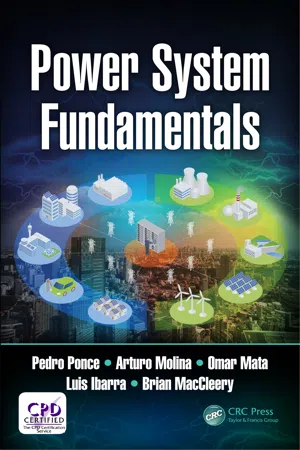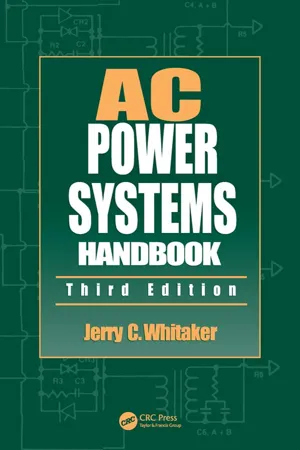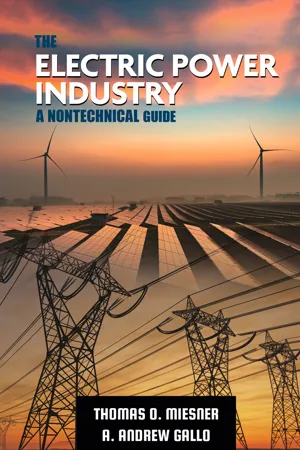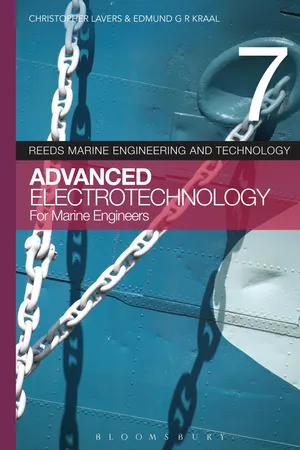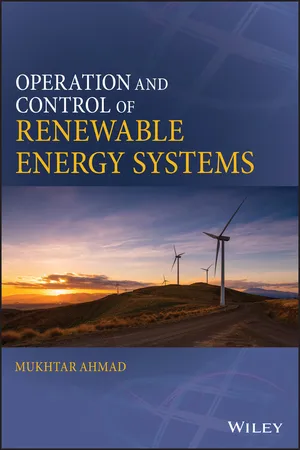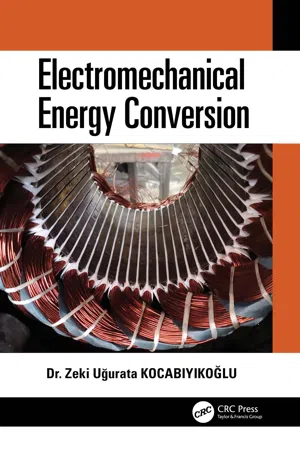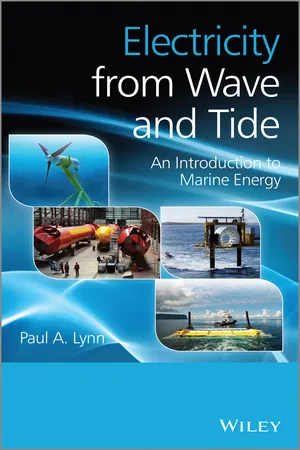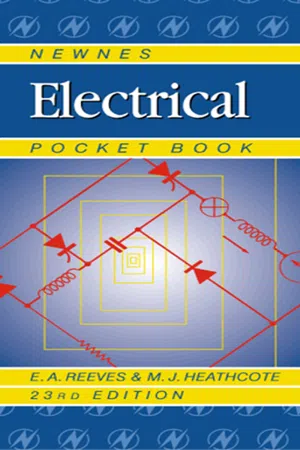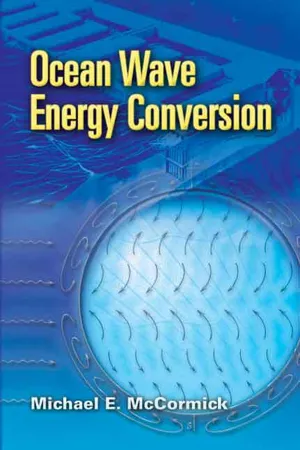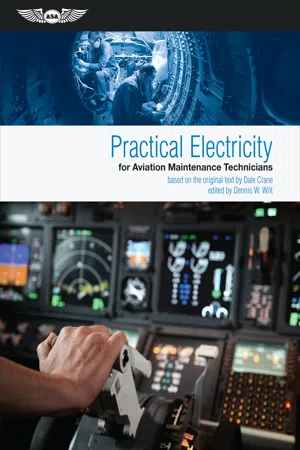Physics
Electric Generators
Electric generators are devices that convert mechanical energy into electrical energy through the process of electromagnetic induction. They typically consist of a coil of wire rotating within a magnetic field, which induces a flow of electric current. This process is fundamental to the generation of electricity in power plants and various other applications.
Written by Perlego with AI-assistance
Related key terms
Related key terms
1 of 4
Related key terms
1 of 3
10 Key excerpts on "Electric Generators"
- eBook - ePub
- Pedro Ponce, Arturo Molina, Omar Mata, Luis Ibarra, Brian MacCleery(Authors)
- 2017(Publication Date)
- CRC Press(Publisher)
Many concepts must be established before performing any analysis of electric machines. The principle of electromechanical energy conversion is the most important law of machine analysis. This theory allows us to establish an expression of electromagnetic torque in terms of machine variables, like the currents and the displacement of the mechanical system. In this chapter, basic principles that will be mentioned are the equivalent circuit representations of magnetically coupled circuits, the concept of a sinusoidally distributed winding, and the winding inductances, among others.2.1 A glance into power flow2.1.1 GeneratorsThe generators produce the electrical energy distributed by a power system. Almost all of the generators in use today produce electrical energy by converting mechanical energy to electrical energy through the action of a magnetic field. The mechanical energy comes from a prime mover, which is the device that spins the generator. Prime movers are usually some form of steam or water turbines, but diesel engines are sometimes used in remote locations. Modern generators generate electrical power at voltages of.13.8 - 24 [ k V ]To construct an electric generator, the principle of “electromagnetic induction” is used, as one of the fundamental elements of matter is precisely the electromagnetic charge composed of a magnetic field and an associated particle-motion electric field. A bosons generator uses a magnetic field to energize electrons kinetically and cause an interaction with other electrons, which results in the generation of electric current and a voltage. Manipulating an electromagnetic force may induce the displacement or movement of electrons, and as a result, an electric current will flow.As the rotor rotates at high speeds thanks to external mechanical energy from the turbine, current flows occur in the stator copper wires (is equal to1 [ A ]6.25 ×10 18 - eBook - ePub
- Jerry C. Whitaker(Author)
- 2018(Publication Date)
- CRC Press(Publisher)
2Power-Generation Systems
_____________________________________________2.1 Introduction
Any ac power system begins with a generating source. Electric Generators are devices that convert energy from a mechanical form into an electrical form. This process, known as electromechanical energy conversion, involves magnetic fields that act as an intermediate medium. The input to the generating machine can be derived from a number of energy sources. For example, in the generation of large-scale electric power, coal can produce steam that drives the shaft of the machine. Typically, for such a thermal process, only about 1/3 of the raw energy (i.e., from coal) is converted into mechanical energy. The final step of the energy conversion is quite efficient, with efficiency close to 100%.2.2 Fundamental Concepts
A simplified diagram of a three-phase generator is shown in Figure 2.1 . Note that poles A’, B’, and C’ represent the start of each of the phase windings, whereas poles A, B, and C represent the ends of each of the windings. As with transformers, the windings of the generator can be connected in either of two ways:• Wye configuration. A circuit arrangement in which the schematic diagram of the windings forms a Y.• Delta configuration. A circuit arrangement in which the schematic diagram of the windings forms a delta.Figure 2.2 illustrates the connection arrangements.The generator shown in Figure 2.1 is a rotating-field type of device. A magnetic field is developed by an external dc voltage. Through electromagnetic induction, a current is induced into each of the stationary (stator) coils of the generator. Because each of the phase windings is separated by 120°, the output voltage of the generator also is offset for each phase by 120° (Figure 2.3 - eBook - ePub
The Electric Power Industry
A Nontechnical Guide
- Thomas O. Miesner, A. Andrew Gallo(Authors)
- 2022(Publication Date)
- PennWell Books(Publisher)
Early in the development of electrical systems, North America adopted one combination of distribution voltage and electrical generation frequency, and Europe developed another. Endless debates ensued trying to prove one was “better” than the other. The truth is each system has its advantages and disadvantages. Once established, it was hard to change, so they continued on. Both follow the same laws of physics and behave largely the same.Electromagnetic Generators
As shown in Figure 3-2 , over 90% of the electricity the world uses today comes from electromagnetic generators that operate on the principle of electrical induction purportedly discovered by Michael Faraday.As already stated several times in this text, electricity and magnetism are directly and causally related. Mr. Faraday discovered that changing the magnetic field around a coil of wire induces an electromagnetic force (emf) in that wire, measured in volts. Magnetic force can be changed by:
A coil is a bundle of wires produced by winding one wire in a circle or other geometric shape. Coils are sometimes generically called windings.Winding vs. Coil- changing the magnetic field strength;
- moving the magnet closer to or farther from the coil;
- moving the coil closer to or farther from the magnet;
- rotating the coil relative to the magnet or the magnet relative to the coil.
The magnet can be either a permanent magnet or an electromagnet.Most generators today rotate the magnet relative to the coil and use electromagnets rather than permanent magnets. Electromagnetic generators consist of three main parts:- Rotor
- Stator
- Exciter
Essentially the opposite of generators, motors have a rotor and stator. In the motor, the current drives the magnetic field making the rotor turn.Electric MotorsNot surprisingly, the rotor rotates, and the stator remains stationary. Either the rotor or the stator produces the magnetic field. The other has conductors – commonly comprised of coils of wire, giving rise to the term coils - Christopher Lavers, Edmund G.R. Kraal(Authors)
- 2014(Publication Date)
- Thomas Reed(Publisher)
vice versa . Thus we have 2 operational modes available to the machine designer but the arrangement of moving field with fixed armature is usually preferred due to reasons to be discussed. A rotating magnetic field which continuously changes direction is also a key principle to A.C. motor operation. The basics of machine construction are here considered before the main A.C. generator theory is given.The A.C. Generator
The A.C. generator or alternator is a machine that converts mechanical energy to electrical energy in the form of alternating current. The term ‘synchronous A.C. generator’ or ‘A.C. generator’ is used as a direct comparison with the ‘D.C. generator’. The term alternator is also used by engineers, although this usually refers to small rotating machines driven by yachts, automotive and other combustion engines. Marine alternators, typically 12 or 24 V, are used in boats and yachts and are similar to vehicle alternators but with adaptation to the harsh salt-water environment. They are designed to be explosion proof so brush sparking will not ignite explosive gas mixtures in an engine room. The main types of A.C. generators in common use today are now considered, generating electricity using the same principle as D.C. generators. When the magnetic field around a rotating conductor changes a current is induced in the conductor. Typically a rotating magnet turns within a stationary set of conductors wound in coils on an iron core. The field cuts across the conductors generating an induced e.m.f. as the mechanical input causes a rotating magnet to turn. A rotating magnetic field will induce an A.C. voltage in the windings. Often there are 3 sets of windings, physically off set so the rotating magnetic field produces a three-phase current, displaced by period with respect to each other.Rotating-armature typeA.C. is always produced in a basic generator. The provision of a reversing switch – or commutator, results in D.C. but, if A.C. is needed slip-rings are used. A machine of this type is constructed like a D.C. generator with a fixed-field system and a moving armature or ‘rotating-armature’ alternator is common for small machines up to 40 kVA and voltages of 450 V. It is a cheaper machine than an A.C. generator constructed on the rotating-field principle, because a D.C. generator or suitably sized motor uses slip-rings, replacing the commutator. A D.C. armature winding is retained and tappings are brought out to the slip-rings, as required for single- or three-phase supply. The number of poles is chosen to suit the speed of the prime-mover and the required frequency. Yoke and field system construction follows D.C. practice and separate excitation. The generator voltage waveform is not exactly sinusoidal but is acceptable for applications where this alternator type is used.- Mukhtar Ahmad(Author)
- 2017(Publication Date)
- Wiley(Publisher)
In the application of conversion of wave energy to electrical energy, linear generators are used as they are more suitable because of translational movement of body by the waves. Linear generators can extract the power of the waves in the form of a reciprocating motion at a low speed. High torque energy is possible with linear generators because of direct extraction of low speed. However, the electrical output voltage obtained is not suitable for direct connection to grid and needs a power electronic circuit for processing of the waveform. The following linear generators are considered for wave-energy-converting power plants:- i. Linear permanent magnet synchronous machines, both with surface and buried permanent magnets
- ii. Vernier hybrid linear machines
- iii. Air-cored permanent magnet tubular linear machines
3.2.1 Induction Generator
An important step for installation of wind energy system is to select the turbine rating, the type of generator, and the distribution system. In general, the output characteristics of the wind turbine power do not follow exactly those of the generator power; so they have to be matched in the best possible way. Based on the range of speed expected for the turbine and taking into account the cubic relationship between the wind speed and the generated power, the generator and the gearbox are selected which match the speeds. For small renewable energy power plants, mostly induction machines are used, because they are widely and commercially available and very inexpensive. It is also very easy to operate them in parallel with large power systems.Induction generators are similar in construction to induction motors. They produce electrical power when their shaft is rotated by a prime mover above the synchronous speed. Induction generators are simpler in construction compared to other generator types. They are also more rugged, requiring no brushes or commutator. The types of induction generators that can be used in wind energy conversion depend on the type of wind turbine. For limited variable-speed turbine, a squirrel-cage or wound-rotor induction generator with rotor resistance variation is used. Wind turbines with variable speed in a long range use a doubly fed induction generator (DFIG) consisting of a wound-rotor induction generator and an ac/dc/ac PWM converter. The stator winding is connected directly to the 50 Hz grid while the rotor is fed at a variable frequency through the ac/dc/ac converter. The DFIG technology is now the most preferred as it allows extracting maximum energy from the wind for low wind speeds by optimizing the turbine speed. There are many advantages of adjustable speed generators (ASGs) compared to fixed-speed generators (FSGs) which will be described later.- eBook - ePub
- Zeki Uğurata Kocabiyikoğlu(Author)
- 2020(Publication Date)
- CRC Press(Publisher)
3 Principles of Electromechanical Energy Conversion3.1 Introduction
Electromechanical devices convert electrical energy into mechanical energy and vice versa. Energy conversion takes place through the medium of magnetic field. Electromechanical energy conversion is a reversible process except for the losses in the system. We can categorise the electromechanical energy conversion devices in the following manner:- Transducers: These are the first category of devices that involve low-energy conversion signals from electrical to mechanical or vice versa. Microphones, sensors, and loudspeakers are typical examples of this category of devices which operate generally under linear conditions.
- Force-producing devices: These are the second category of devices that consist of force- or torque-producing devices with limited mechanical motion. Examples are solenoids, relays, and electromagnets.
- Continuous energy conversion equipment: Examples are motors and generators that are used for bulk energy conversion and utilisation.
In this chapter, we first discuss transducers and force-producing devices and then continuous energy conversion devices. In doing these, we try to keep as short and as less time consuming as possible to understand the basics of the subject.3.2 Forces and Torques in Magnetic Fields
According to Lorentz’s force law, in pure magnetic field systems, the force on a moving particle of charge q is indicated by the following vector cross product:F = q()v →×B →where v is the velocity in m/s of the particle of charge q moving in a magnetic field density of B Tesla (Figure 3.1 - eBook - ePub
Electricity from Wave and Tide
An Introduction to Marine Energy
- Paul A. Lynn(Author)
- 2013(Publication Date)
- Wiley(Publisher)
The above discussion may imply that the DFIG and power converter are operating fairly steadily, but in practice they operate in a highly dynamic environment, adapting to sudden changes in the power produced by the rotor and, in many cases, working with the systems that control pitching of the blades. The fast response of electronic circuits compared with mechanical blade-pitching is another of the DFIG concept's principal advantages, smoothing power flow into the grid and protecting the turbine and its drive train from excessive stresses in turbulent conditions.3.4.4. Linear motion generators
The vast majority of Electric Generators are rotational, equipped with a central shaft and rotor which delivers power across a narrow air gap to a circular stator – a very natural arrangement. But what if the primary mechanical motion is linear or translational, as in a point-absorber WEC that heaves up and down with the waves? Rather than generate electricity via an intermediate hydraulic or pneumatic stage, as described in Section 3.2, or via connecting rods and crankshafts as in conventional diesel engines, is it possible (and sensible) to convert linear motion directly into electricity using a novel form of generator? This question has exercised the minds of wave energy experts for many years and various schemes have been suggested [3]. We focus here on one that is easy to visualise and illustrates the key principles.Figure 3.20 a shows a heaving float that drives a linear generator fixed to the sea bed. The float's motion is directly coupled to a translator which moves up and down between the arms of a stator, generating electricity. We should emphasise straight away that, for simplicity, we have omitted the generator housing, bearings and other important details. A housing is of course necessary to protect the unit and allows the translator to be separated from the stator by a small air gap.Figure 3.20Figure 3.20A linear motion generator. - eBook - ePub
- E A Reeves, Martin Heathcote(Authors)
- 2013(Publication Date)
- Routledge(Publisher)
7 Electricity generationGeneration may be direct current or alternating current but the versatility of the latter together with the availability of units with high ratings, and the robustness and reliability of alternating current plant, have made it universally dominant. Only alternating current generation is dealt with here.Synchronous Generator TheoryAn alternating current generator consists essentially of a magnetic field system produced by direct current, and an armature having windings linking this field system so as to induce an alternating voltage. The field is almost invariably carried on the rotor of the machine which is driven by the power source, possibly a steam or gas turbine in the case of a large unit, or an internal combustion engine for a small generator up to, say, 25 MW. The rotor may be cylindrical or it may have salient, that is readily identifiable, poles. The armature, which produces the alternating output voltage is the stationary part of the machine, or stator. For all but the very smallest machines the output is generally three-phase, at a frequency of 50 Hz in the UK and Europe, and 60 Hz in North America.The form of construction of the machine depends greatly on the power source and speed. To generate at a frequency of f Hz when driven at a speed of n r.p.m. the generator must have 2p poles, such thatwhere n is the synchronous speed, that is the speed of the rotating magnetic field which would be produced by currents at frequency f circulating in the three-phase stator winding. It will be seen that a low speed machine will thus have a large number of pole-pairs and must therefore have a large diameter to accommodate these, while a high-speed machine of similar power will be longer with a smaller overall diameter. The highest machine speed corresponds to two poles (p - eBook - ePub
- Michael E. McCormick(Author)
- 2013(Publication Date)
- Dover Publications(Publisher)
In this chapter, several electromechanical energy conversion systems are discussed. The various methods of transmission and storage are also described.5.1 Basic Electromechanical Energy Conversion Techniques
The eight generic wave energy conversion techniques described in Sections 4.1 and 4.2 (wave focusing is not a conversion technique per se) have one or more possible electromechanical energy conversion techniques associated with them. In this section the two most popular electromechanical systems are described: the mechanical-drive generator and the fluid-drive generator.A Mechanically Excited Generators
Consider the wave energy conversion systems sketched in Figure 5.1 . InFigure 5.1aa heaving float is attached to a line that passes over a pulley connected to a rotating electrical generator and then to a weight. The weight ensures that the line remains in tension. As the float rises the pulley turns in a clockwise direction while the pulley direction is reversed as the float falls. A ratchet device can be used to insure that the generator rotates in only one direction. A variation of this basic system is to replace the weight by a spring-loaded pulley system at the generator, as inFigure 5.1b, where a purely pitching body is sketched using a pully generator device similar to that in Figure 5.1a .Figure 5.1 Basic mechanically excited electrical generation schemes.Figure 5.2 Heaving excited gear-sprocket generator system.Another mechanical-drive system that is often suggested for heaving wave energy converters is the gear system sketched in Figure 5.2 . InFigure 5.2aa heaving circular cylinder is shown attached to a vertical shaft having gears on its right side. These gears mate with a sprocket that, in turn, is attached to the generator shaft. The motions of the cylinder are described by equation (4.12) where, in the case of resonance, the phase angles γ and σz have values of 0 and 90°, respectively. We assume this condition in the analysis that follows; thus at resonance - Dale Crane, Dennis Wilt(Authors)
- 2017(Publication Date)
- Aviation Supplies & Academics, Inc.(Publisher)
8 Electric Motors and GeneratorsElectric motors have become such a standard part of our lives that they are usually taken for granted. They are made in all sizes and power outputs, from the tiny motors that move the hands in analog wrist watches to the motors that drive ocean-going ships. Regardless of their size, all electric motors work on the same principle. One magnetic fields reacts with another magnetic field to produce a physical force.Figure 8-1 shows the basic way an electric motor works. The conductor (represented by the circle) in view A has no current flowing in it, and the lines of flux pass straight across the space from the north pole of the magnet to the south pole. But when current flows in the conductor as in view B, it produces a magnetic field, which surrounds the conductor.Figure 8-1 . When the magnetic field surrounding the conductor distorts the lines of flux between the poles of the magnet, a force is produced that tries to move the conductor out of the magnetic field.The lines of flux between the poles of the magnet try to remain as short as possible, and when they are distorted by the field surrounding the conductor, they produce a physical force that tries to move the conductor to the left, out of their field.The right-hand rule for motors helps understand this action. Hold the fingers of your right hand as shown in Figure 8-2, with the forefinger pointing in the direction of the lines of flux (from the north pole of the magnet to the south pole) and the second finger pointing in the direction of electron flow in the conductor (from negative to positive); the thumb will point in the direction the conductor will move. The amount of force that acts on the conductor is determined by the strength of the two magnetic fields.Figure 8-2
Index pages curate the most relevant extracts from our library of academic textbooks. They’ve been created using an in-house natural language model (NLM), each adding context and meaning to key research topics.
Explore more topic indexes
Explore more topic indexes
1 of 6
Explore more topic indexes
1 of 4
